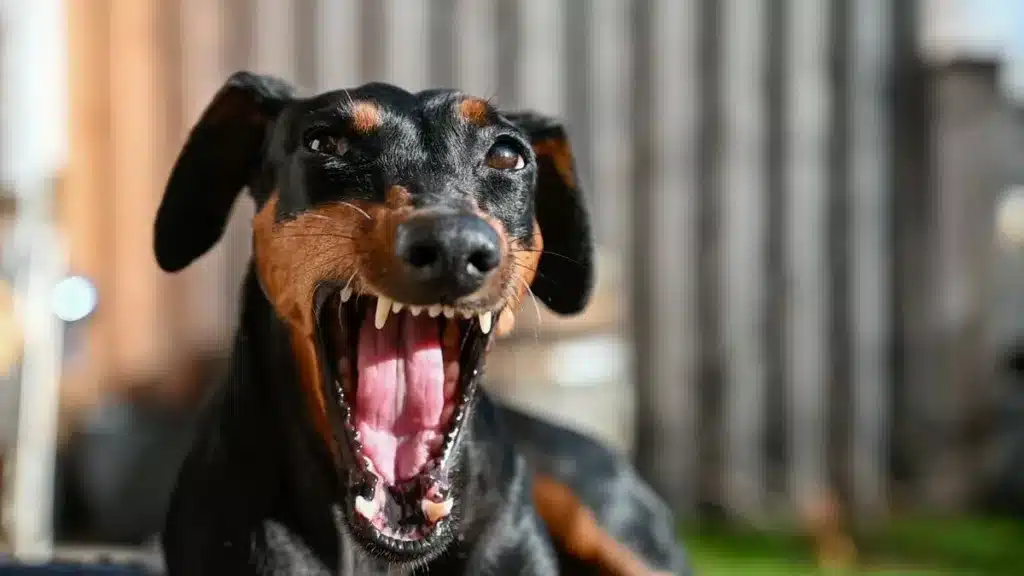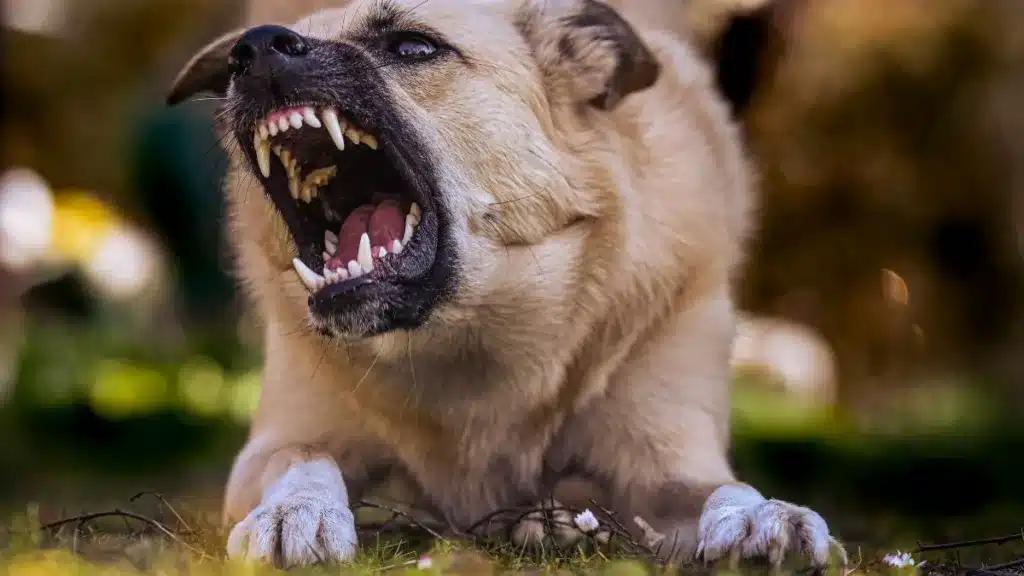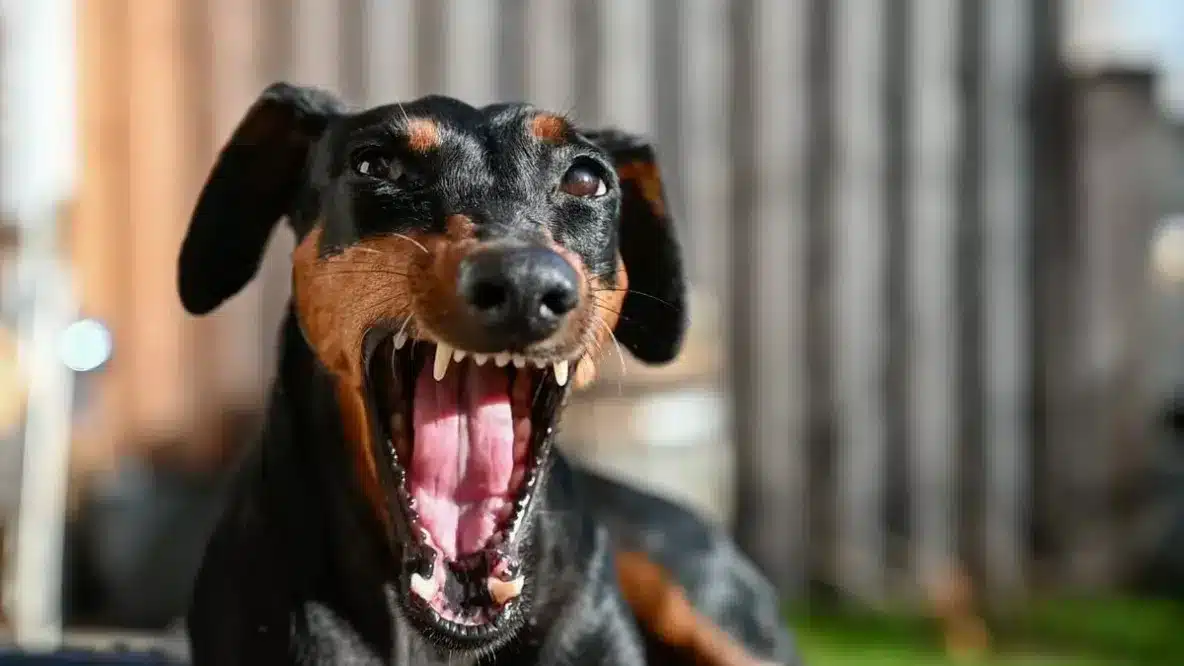
Distinguishing between dog aggression and dog reactivity is crucial, as each requires different management approaches. Understanding your dog’s behavior is essential for creating a safe and harmonious environment for both your pet and those around them.
Aggression is characterized by an intent to injure, whereas dog reactivity involves excessive excitement and a lack of boundaries. Recognizing the signs and underlying causes of these dog behaviors can help you take the necessary steps to address and manage your dog’s actions effectively.
Understanding Dog Aggression
Aggression in dogs is characterized by behaviors intended to cause harm or assert dominance. This can be directed towards humans, other animals, or objects.
Common Causes
- Fear: Defensive aggression when a dog feels threatened.
- Territoriality: Protecting their space from perceived intruders.
- Dominance: Asserting control over other dogs or people.
- Pain: Reacting aggressively to avoid further discomfort.
Signs of Aggression
- Growling
- Snapping
- Biting
- Stiff body posture
- Direct staring
Understanding Dog Reactivity
Dog reactivity refers to an overreaction to certain stimuli, such as other dogs, people, or noises. Reactive dogs may not intend to harm but react intensely due to excitement, fear, or frustration. Reactivity is characterized by excessive excitement and a lack of boundaries.
Common Causes
- Fear: Reacting to scary or unfamiliar situations.
- Overstimulation: High energy and excitement levels in stimulating environments.
- Lack of Socialization: Inadequate exposure to various stimuli during developmental stages.
Signs of Dog Reactivity
- Barking
- Lunging
- Whining
- Excessive excitement
- Pacing
Key Differences Between Dog Aggression and Dog Reactivity
Intent
- Aggression: The intent to injure or assert dominance.
- Reactivity: Typically a response to a specific trigger without harmful intent, often due to excessive excitement.
Body Language
- Aggressive Dogs: Stiff posture, direct staring, and showing teeth.
- Reactive Dogs: Wagging tail, high energy, and jumping or barking.
Situational Context
- Dog Aggression: May occur in various contexts, including territorial defense or dominance.
- Dog Reactivity: Usually triggered by specific stimuli, such as other dogs or loud noises.
Assessing Your Dog’s Behavior
Observation Tips
Watch your dog’s behavior in different situations, noting any aggressive or reactive responses.
Trigger Identification
Keep a journal to track when and where your dog shows aggressive or reactive behavior, noting specific triggers.
Professional Assessment
If unsure, seek help from a professional trainer or behaviorist who can provide an accurate assessment of your dog’s behavior. At PAWS Dog Daycare, we offer behavioral assessments to help you determine whether your dog is aggressive or reactive.

Managing Aggression and Dog Reactivity
Aggression Management
- Desensitization: Gradually exposing your dog to triggers in a controlled manner.
- Positive Reinforcement: Rewarding calm behavior to encourage positive associations.
- Professional Training: Seeking help from experienced trainers or behaviorists.
Dog Reactivity Management
- Counter-Conditioning: Changing your dog’s response to triggers through positive experiences.
- Focus Training: Teaching your dog to focus on you instead of reacting to stimuli.
- Calming Techniques: Using tools like anxiety wraps or calming pheromones.
Training and Socialization
Early and consistent training and socialization are key to preventing and managing both aggression and dog reactivity.
Safety Measures
- Use a leash and muzzle if necessary.
- Avoid situations that trigger aggressive or reactive behavior.
- Educate family members and visitors on how to interact with your dog safely.

Frequently Asked Questions
What not to do with a reactive dog?
Managing a reactive dog requires patience, understanding, and the right strategies. Here are five things you should avoid to prevent exacerbating your dog’s reactivity:
- Don’t Go to the Problem Area and Challenge Your Dog
- Avoid taking your dog to places or situations that trigger their dog reactivity. Forcing your dog to confront their triggers can increase stress and worsen their behavior. Instead, work on gradually desensitizing your dog in a controlled and safe environment.
- Don’t Expect Your Dog to “Just Get Over It”
- Reactive behavior won’t simply disappear over time. Expecting your dog to “just get over it” ignores the underlying issues causing their dog reactivity. It’s essential to address these issues through consistent training and positive reinforcement to help your dog build confidence and feel secure.
- Don’t Look for a Single Solution
- There is no one-size-fits-all solution for managing dog reactivity. Different dogs have different triggers and require tailored approaches. Be open to combining various techniques, such as counter-conditioning, desensitization, and obedience training, to find what works best for your dog.
- Don’t Go into Reactive Situations Without Super Solid Basics
- Ensure your dog has a strong foundation in basic obedience commands before exposing them to potentially reactive situations. Commands like “sit,” “stay,” and “focus” can help redirect your dog’s attention and provide a sense of control in challenging environments.
- Don’t Ignore Your Dog’s Signals
- Pay close attention to your dog’s body language and signals. Ignoring signs of stress or discomfort can lead to an escalation of reactive behavior. By recognizing and responding to these signals early, you can intervene and manage the situation more effectively.
Does dog reactivity go away?
Reactive behaviors typically emerge during adolescence, around 6 to 18 months of age, and often intensify as the dog reaches social maturity, which is around 2 to 3 years old. It’s a common misconception that dogs will “grow out of” reactive behavior on their own. Unfortunately, without proper intervention, these behaviors usually persist and can even worsen over time.
To address dog reactivity effectively, it’s crucial to seek help as soon as you notice any signs of an issue. Early intervention with consistent training, socialization, and behavior modification techniques can significantly improve your dog’s behavior. Working with a professional trainer or behaviorist can provide tailored strategies to manage and reduce your dog’s dog reactivity, helping them become more confident and relaxed in various situations.
Can you desensitize a reactive dog?
Yes, you can desensitize a reactive dog using techniques such as desensitization and counterconditioning. These methods are effective in situations where your pet is fearful or anxious, helping them become more comfortable with the triggers that cause their reactivity.
Desensitization
Desensitization involves gradually exposing your dog to the stimulus that triggers their reactive behavior. The key is to start with a low-intensity version of the trigger and slowly increase its intensity over time. This gradual exposure helps your dog become accustomed to the stimulus without becoming overwhelmed.
Counterconditioning
Counterconditioning works in tandem with desensitization. It involves pairing each exposure to the trigger with a positive experience, such as a favored reward like treats, praise, or play. This helps change your dog’s emotional response to the trigger from negative to positive.
Steps to Desensitize and Countercondition a Reactive Dog:
- Identify Triggers: Determine what specific stimuli cause your dog to react.
- Control the Environment: Start in a controlled environment where you can manage the intensity of the trigger.
- Gradual Exposure: Introduce the trigger at a low intensity. For example, if your dog is reactive to other dogs, start by exposing them to another dog from a distance where they feel safe.
- Positive Reinforcement: Pair the exposure with a reward. Whenever your dog remains calm in the presence of the trigger, reward them with treats, praise, or play.
- Increase Intensity: Slowly increase the intensity of the trigger. This could mean decreasing the distance between your dog and the trigger or increasing the duration of exposure, always ensuring your dog remains comfortable and calm.
- Consistency and Patience: Desensitization and counterconditioning require consistent practice and patience. Progress at your dog’s pace and avoid pushing them too quickly.
Should you punish a reactive dog?
Punishing a reactive dog is not recommended. Using punishment methods such as yelling, jerking the leash, grabbing your dog, or saying “no” can increase their anxiety and stress levels. Instead of addressing the root cause of the reactivity, punishment may suppress warning signs like growling or barking, which are critical signals that a dog might bite.
Why Punishment is Ineffective and Harmful:
- Increased Anxiety: Punishment can heighten a dog’s anxiety and fear, making them more reactive in the long run.
- Suppression of Warning Signs: Correcting behaviors like growling or barking might stop these actions temporarily, but it removes important warning signs that indicate a dog is uncomfortable and might bite. Without these signals, a dog might bite without warning.
- Damaged Trust: Punishment can damage the trust between you and your dog, making them less likely to feel safe and secure around you.
Alternative Approaches:
- Positive Reinforcement: Focus on rewarding calm and desirable behaviors. Use treats, praise, and affection to reinforce positive actions.
- Desensitization and Counterconditioning: Gradually expose your dog to their triggers at a comfortable intensity and pair each exposure with positive experiences, such as treats or play.
- Redirecting Attention: Teach your dog to focus on you instead of the trigger. Commands like “look” or “watch me” can help redirect their attention and reduce reactivity.
- Professional Training: Seek help from a professional trainer or behaviorist who specializes in positive reinforcement techniques and behavior modification. They can provide tailored strategies for managing and reducing reactivity.
Is a reactive dog the owners fault?
Don’t blame yourself if your dog is reactive. Many owners do their best to provide positive socialization for their puppies, and it’s not your fault if your dog still ends up reactive. Your efforts to socialize your puppy likely helped to bring out the best in them and may have even mitigated some of their reactivity.

